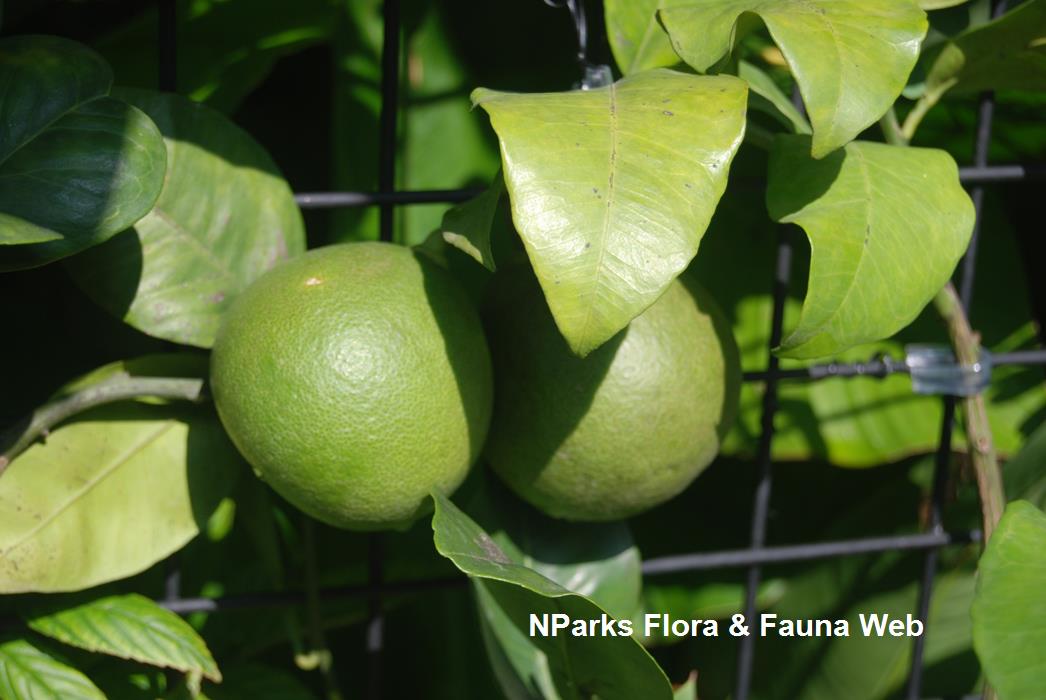
Back
Citrus maxima (Burm.) Merr.
| Family Name: | Rutaceae |
| Synonyms: | Citrus grandis (L.) Osbeck |
| Common Name: | Pomelo, Limau Bali, Limau Besar, Shaddock, Pummelo, Limau Betawi, 柚子 |
Name
Classifications and Characteristics
| Plant Division | Angiosperms (Flowering Seed Plants) (Dicotyledon) |
|---|---|
| Plant Growth Form | Tree |
| Lifespan (in Singapore) | Perennial |
| Mode of Nutrition | Autotrophic |
| Chromosome Number | 18 |
| Maximum Height | 15 m |
Biogeography
| Native Distribution | Malesia |
|---|---|
| Native Habitat | Terrestrial |
| Preferred Climate Zone | Tropical |
| Local Conservation Status | Non-native (Horticultural / Cultivated Only) |
Description and Ethnobotany
| Growth Form | A tree, it can grow up to 5 to 15m in height with low, irregular branches. Long spines, up to 5cm long are found on the branches of plants propagated via seeds but are absent in those propagated through vegetative means. The young, tertiary branches are angular and often hairy. |
|---|---|
| Foliage | The leaves are obovate to elliptical. |
| Flowers | The yellow-white, bisexual flowers are fragrant and are borne singly or in clusters of 2 to 10 flowers in the leaf axils. The plant flowers 2 to 3 times a year in the tropics. The flowering season coincides with shoot growth flushes. |
| Fruit | The fruit is globular to a pear-shaped (pyriform). It has a thick but soft peel about 1 to 4cm thick, the outer surface of the peel is greenish-yellow to yellow and is dotted with green glands. The peel is easily separated from the segements, consisting of pale yellow or pink pulp-vesicles filled with sweet juice. The seeds are few and ridged. |
| Cultivation | It is ideally grown in the lowland tropics, at altitudes below 400m, in temperatures of 25 to 30°C under full sun. It can tolerate a wide range of soils but is ideally grown in deep, medium-textured, fertile soils. |
| Ethnobotanical Uses | Edible Plant Parts : Edible Fruits Food (Fruit or Vegetable): The fruit is usually eaten fresh or used in fruit salads. The white inner part of the peel may be candied after the outer peel has been removed. It is usually eaten in Asia during festivals such as Mid-Autumn Festival were it is eaten as the shape of the fruits and its time of harvest makes it associated with the moon. Others: The aromatic flowers are used to make perfume. |
Landscaping Features
| Desirable Plant Features | Ornamental Flowers, Fragrant (Flowers) |
|---|---|
| Landscape Uses | Parks & Gardens, Small Gardens |
| Thematic Landscaping | Economic Garden |
| Usage Hazard - Cons | Spines/Thorns - Stem/Branch |
Fauna, Pollination and Dispersal
| Fauna Pollination Dispersal Associated Fauna | Butterfly Host Plant (Associated with: Papilio memnon agenor (Linnaeus, 1758)) |
|---|
Plant Care and Propagation
| Light Preference | Full Sun |
|---|---|
| Water Preference | Moderate Water |
| Plant Growth Rate | Fast to Moderate |
| Rootzone Tolerance | Fertile Loamy Soils |
| Propagation Method | Seed, Air-Layering |
Foliar
| Foliage Retention | Evergreen |
|---|---|
| Mature Foliage Colour(s) | Green |
| Leaf Area Index (LAI) for Green Plot Ratio | 3.0 (Tree - Intermediate Canopy) |
Floral (Angiosperm)
| Flower & Plant Sexuality | Bisexual Flowers |
| Flower Colour(s) | White |
|---|---|
| Flower Grouping | Cluster / Inflorescence |
| Flower Location | Axillary |
Fruit, Seed and Spore
| Mature Fruit Colour(s) | Green, Yellow / Golden |
|---|---|
| Mature Fruit Texture(s) | Waxy |
| Fruit Classification | Simple Fruit |
| Fruit Type |
Image Repository
Others
| Master ID | 1516 |
|---|---|
| Species ID | 2809 |
| Flora Disclaimer | The information in this website has been compiled from reliable sources, such as reference works on medicinal plants. It is not a substitute for medical advice or treatment and NParks does not purport to provide any medical advice. Readers should always consult his/her physician before using or consuming a plant for medicinal purposes. |














